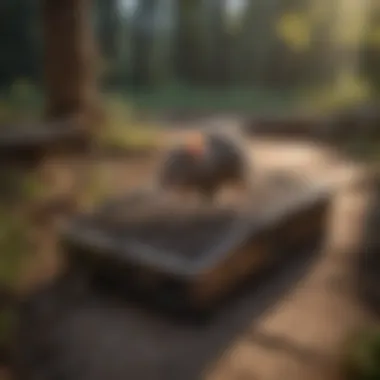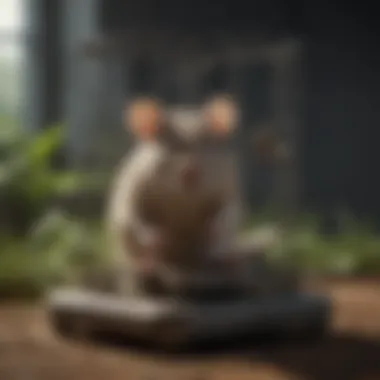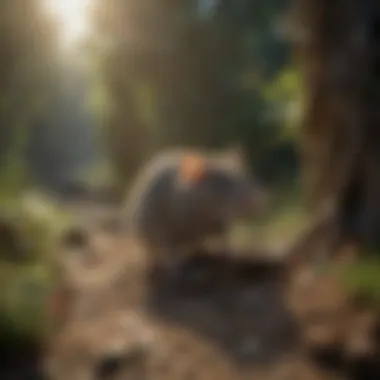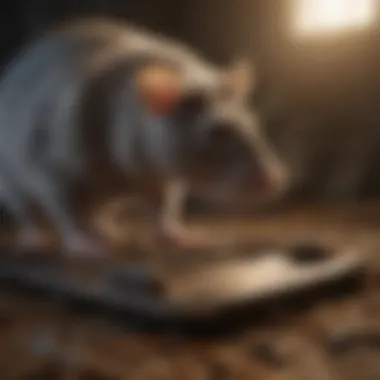Exploring the Good Nature Rat Trap's Design and Impact


Intro
Rodents have been a persistent challenge for households and businesses alike. Their ability to reproduce rapidly and adapt to various environments makes effective control measures crucial. The Good Nature rat trap presents a unique approach, promising efficiency while also being eco-friendy. This article delves into the mechanisms that make this trap effective, comparing it with traditional methods, and discussing its broader implications in pest management.
Understanding the Pest
Identification
Identifying rats correctly is the sfirst step in addressing an infestation. Common species include the Norway rat and the roof rat. Norway rats have a stocky build with short ears and tails, while roof rats are slender with large ears. Knowing the specific type is vital, as it informs the choice of control measures.
Life Cycle
Rats reproduce rapidly. A female rat can have up to five litters each year, with as many as twelve offspring in each litter. The young reach maturity in about three months, leading to a quickly escalating population. Understanding this cycle allows homeowners to appreciate the importance of swift action in controlling rat populations.
Pest Prevention Strategies
Environment Modification
Preventing rat infestations starts with modifcation of the environment. Homes should be kept clean and clutter-free. Food should be stored in sealed containers. Cracks and gaps in walls and foundations can be entry points for rodents; sealing these off is essential.
Physical Barriers
Using physical barriers is another effective strategy. Wire mesh, securely installed, can block off entry points. Additionally, the Good Nature rat trap can be used as a proactive measure. Its design ensures that it is less likely to pose a risk to non-target species.
Control Methods
Chemical Control
Chemical control methods, such as rodenticides, have their own set of challenges. While they can be effective, they often pose risks to pets and wildlife. The Good Nature rat trap provides an alternative by relying on mechanical means, reducing these risks.
Biological Control
Lastly, biological control involves introducing natural predators to manage rodent populations. However, this approach can be complex and requires careful consideration of ecological impacts. The Good Nature trap aligns with this principle by emphasizing humane rodent control without disrupting local ecosystems.
"Innovative pest control methods like the Good Nature rat trap exemplify modern solutions, combining effectiveness with environmental responsibility."
Prelims to the Good Nature Rat Trap
The importance of understanding the Good Nature Rat Trap lies in its innovative approach towards rodent control. As urban areas grow and natural habitats are disrupted, the need for effective pest management has become essential. This trap is designed not only to address the immediate problem of rats but also to do so in a way that respects the environment. This article will analyze the specific benefits of the Good Nature Rat Trap and explain its mechanisms in detail.
Objective of the Article
The primary objective of this article is to provide a thorough examination of the Good Nature Rat Trap. This includes discussing its design principles, operational mechanisms, and overall effectiveness in pest control. By focusing on the features that set this trap apart from traditional methods, readers will gain insights into its practical advantages. This exploration will offer valuable information for homeowners faced with persistent rodent issues, helping them make informed decisions regarding pest management strategies.
Importance of Eco-Friendly Rodent Control
Understanding eco-friendly rodent control is crucial in today’s context of environmental awareness. Traditional methods often involve toxic chemicals or harmful traps that can endanger wildlife and pollute ecosystems. The Good Nature Rat Trap stands out in this respect. It employs a model that minimizes environmental impact. By opting for a more humane and strategic approach to pest control, homeowners can protect their gardens, homes, and local wildlife simultaneously. This is especially relevant in urban settings where human-wildlife interactions are frequent.
In summary, the Good Nature Rat Trap represents a shift towards sustainable pest solutions. It combines efficiency with an ecological perspective, making it an attractive option for those serious about balancing effective rodent control with environmental responsibility.


Design and Mechanics of the Good Nature Rat Trap
The design and mechanics of the Good Nature Rat Trap are fundamental to comprehending its effectiveness and overall utility as a rodent control solution. Understanding these aspects allows homeowners and pest control professionals to make informed decisions regarding their pest management strategies. The importance of mechanics lies in how the trap interacts with its environment, ensuring that it captures rats effectively while minimizing unintended consequences. Here, we will discuss the design overview, its mechanisms of operation, and the safety features built in to enhance user experience.
Overview of the Trap's Design
The Good Nature Rat Trap exhibits a sleek and functional design. Its dimensions are optimized for both indoor and outdoor use, facilitating adaptability in various settings. Made from durable materials, the trap withstands environmental variables, ensuring longevity. The intuitive layout features clear indicators for installation, maintenance, and operation, making it user-friendly, even for individuals with limited experience in pest control.
Functionality is central in trap design. The trap is engineered to be baited easily, with a compartment designed for attractive rodent lures. Its construction minimizes the chance of accidental triggering, which is especially significant in environments where children or pets might be present. Furthermore, the aesthetic of the trap blends into the surroundings, reducing the visibility of unsightly pest control measures. This combination of form and function highlights its advanced engineering.
Mechanism of Action
Understanding the mechanism of action is crucial for grasping how the Good Nature Rat Trap effectively addresses rodent infestations. The trap employs a spring-loaded system that activates upon the rat's entry. When a rat triggers the mechanism, it is swiftly immobilized, ensuring a quick and humane capture. This design contrasts sharply with traditional traps, which often rely on less efficient methods.
Another essential feature of the mechanism is its ability to reset automatically. After a successful capture, the trap can be easily reset without needing to handle the captured rat, which minimizes direct contact. This is particularly advantageous for users concerned about hygiene and disposal. The auto-reset capability means that a single trap can handle multiple entries over time, enhancing its efficiency and reducing overall pest control costs.
Safety Features of the Trap
Safety is a major concern for anyone using a rat trap, especially in households with children and pets. The Good Nature Rat Trap integrates several safety features to address these concerns effectively. Its design includes toe-holds that prevent accidental activation by non-target species, reducing the risk of unintended captures.
The trap also employs a closed design, which protects users from direct contact with the captured rat. Non-toxic materials are used, aligning with eco-friendly principles. This aspect is essential for households that prioritize sustainability. Furthermore, user instructions are clear and concise, guiding the user on safe handling and optimal placement of the trap.
Comparative Analysis with Traditional Traps
The Good Nature rat trap stands out in the realm of rodent control, especially when compared to traditional traps. Understanding the nuances between these methods is crucial for those seeking effective pest management solutions. This comparative analysis explores key elements such as effectiveness, usability, and limitations.
Effectiveness in Catching Rats
The effectiveness of the Good Nature rat trap in catching rats is a significant selling point. Traditional traps often have limited success, which can be attributed to various factors, such as bait attraction and positioning. In contrast, the Good Nature trap employs a unique mechanism that attracts rats through natural scents. This design not only increases catch rates but also reduces the chance of false triggers. Users have reported notable success, sometimes seeing improved results after just a few days of deployment.
Advantages in Use
The Good Nature trap offers several advantages over its traditional counterparts:
- Reusability: Unlike disposable traps, the Good Nature model can be reused multiple times, making it more economical in the long run.
- Ease of Setup: Many users find that installation is straightforward, requiring minimal tools. This is a significant benefit for homeowners without previous pest control experience.
- Eco-Friendly: Being aligned with sustainable practices, the trap’s design minimizes impact on the environment. This aspect is becoming increasingly important for users concerned about ecological footprints.
- Safety: With a design that protects pets and children, the Good Nature trap stands out as a safer alternative for households.
Disadvantages and Limitations
Despite its advantages, the Good Nature rat trap does have some drawbacks. Some users report issues such as:
- Cost: The upfront price may be higher compared to traditional traps, which can deter some budget-conscious customers.
- Effectiveness in High Infestation Areas: In extreme cases of rodent infestation, users may find that traditional snap traps work quicker and more efficiently.
- Maintenance: While the trap is designed for reusability, users must be diligent about cleaning and resetting to ensure continued effectiveness. Neglect in maintenance could lead to reduced performance.
"While the Good Nature trap offers innovative solutions to pest control, it is essential for users to understand its limitations alongside its benefits." - User Review
User Experience and Feedback
User experience and feedback are crucial when evaluating the Good Nature rat trap. Understanding how users interact with the trap can provide insights on its practicality and effectiveness. Reviews from diverse customers help outline its usability and reveal potential areas for improvement.
Information gained from user feedback can help prospective buyers make informed decisions. It serves as a real-world test of the trap's performance beyond mere claims of marketing.
Installation and Setup Process


Setting up the Good Nature rat trap is designed to be straightforward. The manufacturer provides clear instructions, allowing even those with limited DIY experience to install it competently. Users typically report that the entire process takes no more than a few minutes.
- Choosing Location: Begin by identifying strategic locations near signs of rodent activity. These spots include along walls, near gnawed items, or droppings.
- Placing the Trap: Secure the trap with the supplied mounting options to ensure stability. This step minimizes the risk of accidental dislodgment or misfires.
- Baiting the Trap: Following the instructions, use recommended bait for optimal efficacy. It's essential to apply an appropriate amount without overcrowding.
- Monitoring: Regular checking of the trap allows users to gauge its performance frequently.
Overall, the setup process is designed to enhance user confidence and maximize efficiency with minimal fuss.
Effectiveness Reports from Users
The effectiveness of the Good Nature rat trap has been assessed through numerous user reports. Many customers appreciate the high success rate in catching rats, corroborating the claims of the company.
- High Capture Rate: Users frequently highlight a noticeable decrease in rat sightings after setting up the trap, confirming its ability to attract and capture rodents.
- Eco-Friendly: Several reviews commend the environmentally conscious design, aligning with users' desires for sustainable pest control options.
- Ease of Maintenance: Many find cleaning and resetting the trap simple, contributing positively to their overall experience. Users report that once set up, it requires minimal intervention.
However, some feedback indicates mixed results, with a few users citing delays in rodent capture. This emphasizes the need for proper positioning and bait application.
Common Challenges Faced by Users
While the Good Nature rat trap generally receives favorable reviews, users have encountered some challenges. Acknowledging these can help future users.
- Initial Skepticism: New users sometimes exhibit doubt about the trap's effectiveness. This is common when transitioning from traditional traps.
- Learning Curve: Some customers mention a brief adjustment period in understanding optimal baiting and positioning strategies.
- Non-Target Species: Occasionally, users report unintended interactions with non-target species, which can complicate the pest management approach they initially planned.
In summary, sharing user experiences and feedback facilitates a richer understanding of the Good Nature rat trap. Users benefit from insights garnered through real applications and consequences experienced during various rodent control efforts.
Ecological Considerations
The Good Nature rat trap is more than just a device for catching rodents. Its design and functionality raise important discussions around ecological considerations in pest management. Within this realm, several specific elements are key to understanding the trap's role in sustainable practices. These factors include sustainability in manufacturing and use, potential impacts on non-target species, and how the trap fits within integrated pest management strategies.
Sustainability of Rat Traps
The sustainability of the Good Nature rat trap arises from its eco-conscious design and usage factors. Made from durable materials, it is built to last. This longevity translates to reduced waste, as it minimizes the frequency of replacements commonly seen with traditional traps. Additionally, the trap operates without poisons. This is significant because it eliminates the secondary poisoning risk posed to other wildlife.
Moreover, the eco-friendly aspects extend to the ethics behind its production processes. Companies that prioritize sustainability often engage in responsible sourcing, which impacts the environmental footprint of the product. Consumers are increasingly aware of these factors, making it essential for such products to meet the growing demand for greener alternatives.
Impacts on Non-Target Species
Non-target species are any animal that may be affected when trapping rodents. One attraction of the Good Nature rat trap is its design that intentionally minimizes impact on these species. Conventional traps often face criticism for harming unintended targets, including pets and beneficial wildlife. The Good Nature trap features mechanisms intended to isolate and catch only the rats, reducing the chances of incidental captures. This reduces fatalities and injuries among wildlife, aligning with modern environmental philosophies advocating for biodiversity.
"It is essential to mitigate risks to non-target species while maintaining effective rodent control."
This focus on non-target species also satisfies regulatory concerns around wildlife protection laws. By ensuring that such traps are safe for various wildlife, users can feel more confident that they are making responsible choices in their pest management strategies.
Contribution to Integrated Pest Management
The Good Nature rat trap plays a notable role in integrated pest management (IPM), which is a holistic approach to controlling pests through a combination of methods. IPM emphasizes the use of various strategies for sustainable outcomes. The trap complements these strategies by providing a non-lethal method of control that supports the overall health of the ecosystem. For instance, its use could coincide with habitat modifications or biological controls that further mitigate pest problems.
Incorporating the trap into an IPM strategy helps balance efficacy in rodent control while considering ecological health. By participating in this framework, homeowners can not only manage rodent issues but also contribute to larger environmental goals.
This cohesive approach emphasizes the importance of understanding how tools like the Good Nature rat trap integrate with broader ecological and pest management objectives.
Regulatory and Safety Standards


Understanding the regulatory and safety standards surrounding pest control methods is essential. These standards ensure the tools we use, such as the Good Nature Rat Trap, align with safety and environmental guidelines. This adherence is not just about compliance; it is about fostering trust among users and protecting communities.
Compliance with Agricultural Regulations
The Good Nature Rat Trap must conform to specific agricultural regulations that govern the use of pest control devices. These regulations are designed to ensure that traps do not pose unnecessary risks to agricultural produce or the environment. Compliance involves extensive testing and certification processes that confirm the device’s effectiveness while minimizing unintended consequences.
For users, this compliance means they can deploy these traps with confidence, knowing that their use will not adversely affect crops or livestock. Additionally, adhering to these regulations helps maintain the integrity of pest control methods in various agricultural settings.
Consumer Safety Guidelines
In addition to agricultural regulations, consumer safety guidelines play a critical role in the design and implementation of traps like the Good Nature Rat Trap. These guidelines are oriented toward ensuring that traps are manufactured with safe materials and that their operation does not pose hazards to human health or non-target animals.
Manufacturers must provide clear instructions for assembly, placement, and maintenance, ensuring ease of use without compromising safety. Users should know that safe rodent control involves not just efficacy in dealing with pests but also consideration for the broader community.
"Understanding the regulations helps users make informed choices and fosters a responsible approach to pest management that benefits everyone."
By prioritizing compliance with these regulations and guidelines, the Good Nature Rat Trap exemplifies a conscientious approach to pest control, combining effectiveness with the safety and well-being of users and the environment.
Future Developments in Rodent Control Technology
The focus on future developments in rodent control technology highlights the ongoing evolution of methods to effectively manage rodent populations while adhering to sustainable practices. As awareness of environmental issues grows, there is a pressing need for innovations that prioritize eco-friendly solutions. These future developments promise not only efficiency but also alignment with consumer preferences for less harmful impact on the ecosystem. This section will delve into the latest trends and innovations that are shaping the landscape of rodent control.
Trends in Eco-Friendly Solutions
In recent years, the demand for eco-friendly solutions in pest control has increased significantly. Homeowners and professionals alike are recognizing the benefits of using non-toxic and sustainable approaches in managing rodent issues. Some significant trends include:
- Biological Control: Biological methods involve using natural predators or pathogens to control rodent populations. The use of such organisms encourages a balanced ecosystem and reduces reliance on chemical solutions.
- Repellent Technologies: New methods such as ultrasonic repellents are gaining popularity. These devices emit sounds that irritate rodents without harming them, prompting their departure from treated areas.
- Smart Traps: Technology-driven traps utilize sensors to detect rodent activity. They can send alerts to homeowners, allowing for timely intervention without frequent checking of physical traps. This promotes less disturbance to the environment.
These trends reflect a broader movement towards developing products that are both effective and responsible. By adopting these solutions, users contribute to a healthier environment while addressing rodent problems effectively.
Innovations in Trap Design
Current advancements in trap design aim to enhance effectiveness and user-friendliness. The design of traps has evolved significantly. Some key innovations include:
- Modular Systems: Newer traps offer modular designs that allow users to customize according to their needs. This flexibility makes them more appealing for various settings.
- Non-lethal Options: Many traps are now designed to capture rodents alive, enabling owners to release them safely. This non-lethal approach appeals to those who prioritize humane solutions.
- Durability and Weather Resistance: Modern materials used in trap construction improve resistance to weather conditions, ensuring that traps function correctly in various environments.
"Innovations in trap design are not just about efficiency; they reflect a commitment to ethical and environmental considerations."
These innovations not only make traps more effective but also provide a clearer alignment with consumer expectations for sustainability and ethical treatment of animals. As the industry continues to advance, the combination of these trends and innovations sets the stage for a future where rodent control becomes increasingly responsible and effective.
Closure
The conclusion of this article emphasizes the significance of understanding the Good Nature rat trap and its implications for effective rodent control. This trap not only offers a humane approach to pest management but also aligns with eco-friendly practices that are increasingly relevant today. An important aspect of this conclusion is the summary of the key findings from previous sections, underscoring the innovative design and mechanisms that set the Good Nature trap apart from traditional methods.
Summary of Findings
The main takeaways from the evaluation of the Good Nature rat trap include its unique operational mechanism which utilizes a spring-loaded design, ensuring a swift and effective capture of rodents. Feedback from users indicates high satisfaction regarding its efficacy in reducing rat populations in various settings, from urban homes to agricultural environments. Additionally, the trap's construction utilizes materials that contribute positively to sustainability, showcasing a commitment to reducing environmental impact.
This article also highlights the trap's compliance with safety standards, ensuring that it is a reliable choice for households, particularly those with pets and children. By exploring its user experience and addressing any common challenges, we gain insight into the practicality of utilizing this trap in real-world applications.
Final Thoughts on the Good Nature Rat Trap
In summary, the Good Nature rat trap emerges as a superior solution in the realm of pest management. Its design prioritizes both function and environmental responsibility, making it a front-runner among modern trapping solutions. For homeowners and professionals alike, investing in this trap means investing in a method that is not only effective but also ethical. The overarching conclusion throughout this article serves as a call to reevaluate traditional rodent control methods in favor of more innovative and sustainable options like the Good Nature rat trap.
"Adopting effective and eco-friendly solutions for pest management can significantly contribute to a healthier environment."
With the evidence presented, it is clear that embracing such advancements in rodent control can lead to better outcomes for both residential and agricultural needs.







